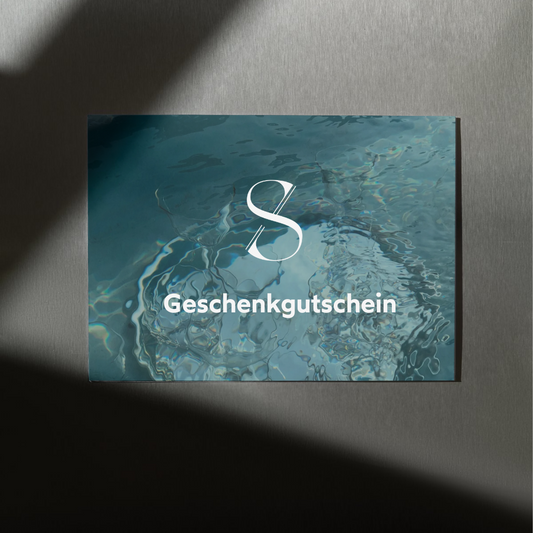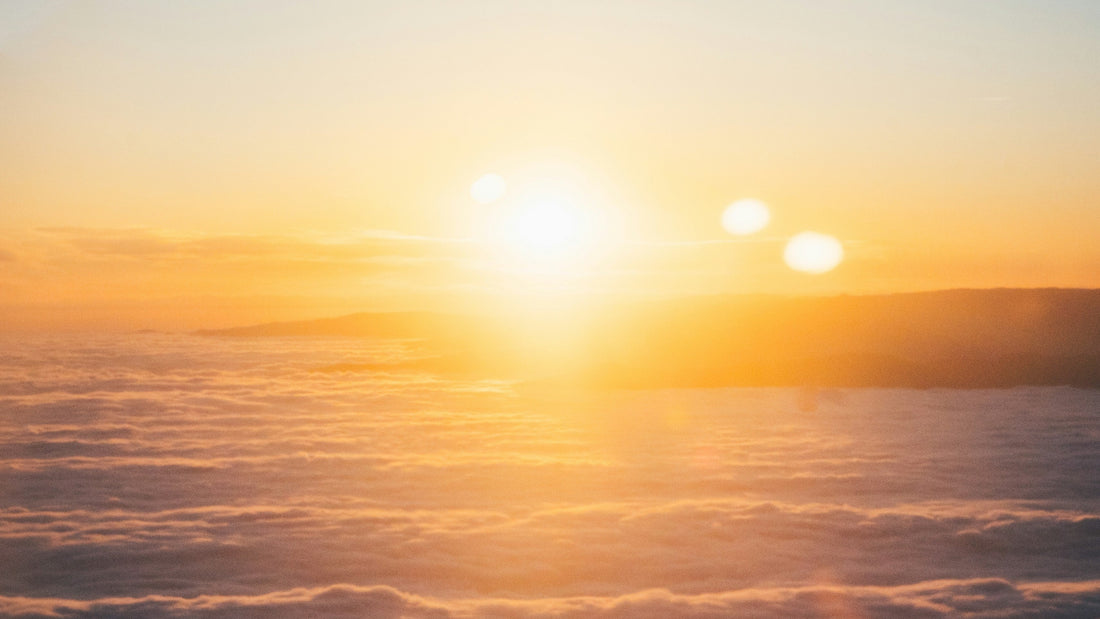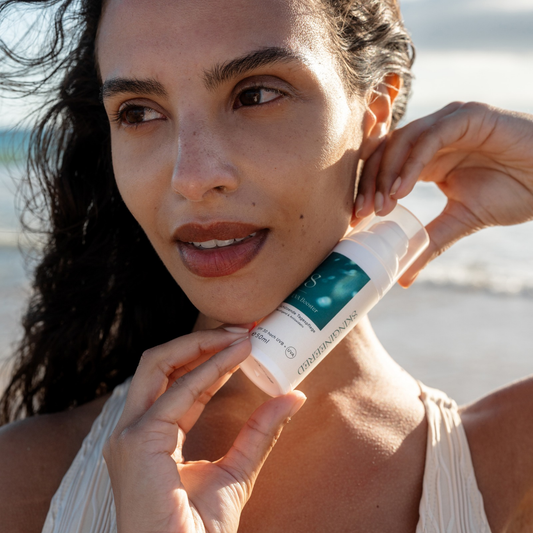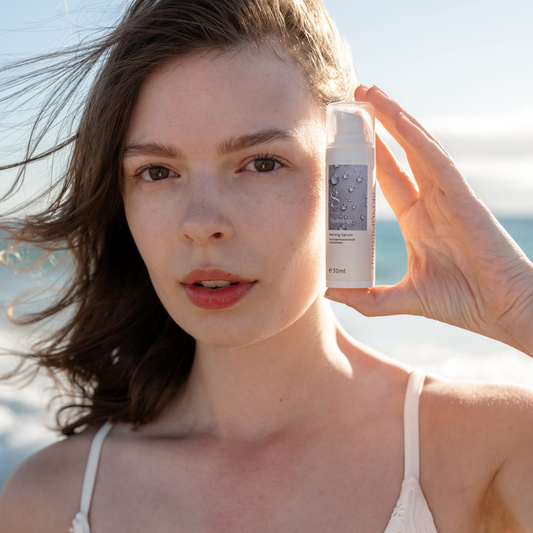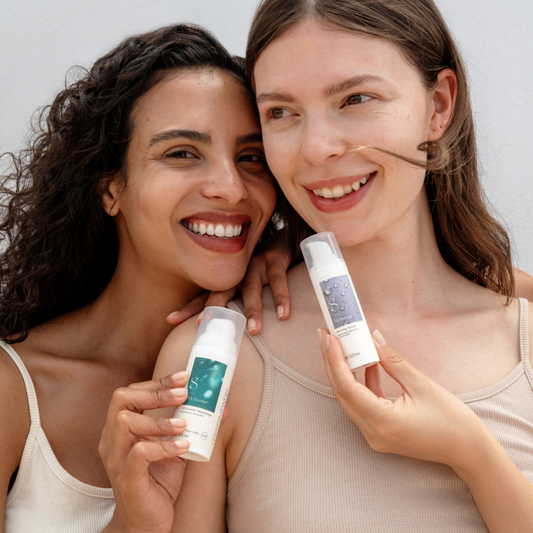What does SPF really mean, and how long does it protect you from UV radiation? In this article, you'll learn how to calculate your safe time in the sun and why generously applying sunscreen is so important.
Overview:
- What does SPF mean?
- How much sunscreen should I apply?
- What is my self-protection time ?
- How long can I stay in the sun with SPF?
- What if I apply sunscreen too late ?
What does SPF mean?
What does SPF (sun protection factor) actually mean? Common misconceptions are that the number has something to do with the temperature or the proportion of UV filters in the formulation. No, an SPF 50, for example, indicates:
The radiation that damages my skin is reduced 50-fold.
This means that only 2% of the radiation gets through. 98% is absorbed and rendered harmless by the protective film.

Nerd fact: The function between SPF and transmission (T: radiation that is transmitted) is approximately as follows: SPF = 1/T This also makes it clear that even an extremely high protection factor can never provide 100% protection.
Let's do a few calculations to show what this means for absorption and SPF. This might give you a sense of the relationship:
Table: Relationship between absorption, transmission and SPF
| absorption | transmission | SPF |
| Calculation: | =100% - absorption | = 1/T |
| 50% | 50% | 2 |
| 67% | 33% | 3 |
| 80% | 20% | 5 |
| 90% | 10% | 10 |
| 93% | 7% | 15 |
| 95% | 5% | 20 |
| 97% | 3% | 30 |
| 98% | 2% | 50 |
| 98.3% | 1.7% | 60 |
What can I learn from this? The time I can safely spend in the sun is extended. It is multiplied by the SPF:
Self-protection time x SPF = protected time
How much sunscreen should I apply?
That's the theory. However, the calculated protected time only applies under ideal conditions, which are almost never achieved in practice. A generous amount must be applied. Studies show that most people only apply 1/4 of the required amount to achieve the SPF (1). This reduces the level of protection enormously. The stated SPF applies to an application amount of 2mg/cm² of skin. This equates to approximately 1g for the face and 30g for the body (depending on size). Good guidelines are, for example, 1/4 teaspoon for the face or a shot glass for the body. Or two finger lengths of sunscreen for each body region (head, arm, chest, stomach, lower legs, etc.).

With the UVA booster, you get exactly the right amount for your face with just one pump.
In addition, swimming, sweating, rubbing, etc., contribute to the protective film diminishing over time. Therefore, in intense sun exposure, reapplying sunscreen every two hours and after swimming is recommended.
Rule of thumb: Even a careful user should only ever use about half of the theoretically calculated protection time (2). Also, always seek shade whenever possible and wear long clothing.
What is my self-protection time?
First of all, how do I know how long I can stay in the sun unprotected?
In 1975, dermatologist Fitzpatrick classified people into six different skin types based on skin, hair, and eye color, as well as characteristics such as freckles, and assigned them an approximate self-protection time (3). We still use this classification today because it is easy to understand. Skin types I to IV are the most common in Europe and can stay in the sun unprotected for an average of about five to 30 minutes. That's not very long! For children, a self-protection time of five minutes is always assumed.

Skin type I: Celtic type
People with skin type 1 have very fair skin and often reddish or light-blonde hair. Their eyes are typically blue, green, or light gray. They freckle easily and their skin doesn't usually tan. ( Self-protection time: less than 10 minutes)
Skin type II: Nordic type
People with Nordic skin types also have very fair skin. Their hair is blonde or light brown, and their eyes are blue, gray, or green. Their skin tans hardly or only very slowly. ( Self-protection time: 10-20 minutes)
Skin type III: mixed type
Most people in Central Europe belong to the mixed type. They have light to medium skin color. Their hair color ranges from blond to black, and their eye color varies between brown, blue, gray, and green. Their skin tans slowly in the sun. ( Self-protection time: 20-30 minutes)
Skin type IV: Mediterranean type
The Mediterranean type naturally has a lightly tanned or olive skin tone. People with this skin type usually have dark hair and brown eyes. Their skin tans quickly. ( Self-protection time: approx. 45 minutes)
Skin type V: Dark type
People with this skin type always have dark skin, often with a gray undertone. They have dark eyes and black hair. Freckles do not appear in this skin type, and the skin tans quickly. ( Self-protection time: approx. 60 minutes)
Skin type VI: Black type
People with skin type 6 have a dark brown to black skin color even without sun exposure. Their hair and eyes are dark brown to black. They do not have freckles. ( Self-protection time: approx. 90 minutes)
Even dark skin types cannot remain unprotected in the sun indefinitely. Unfortunately, skin cancer diagnoses are still very unreliable, especially in dark skin types, because dermatology is almost exclusively taught on light skin (4). Sun protection is relevant for all skin types !
The natural protection times of different skin types also show that they don't differ that much, and "pre-tanning" offers hardly any protection. Even if the natural protection time increases from 10 to 20 minutes, that only corresponds to a factor of 2! Since UV-induced tanning is always a sign of skin damage, it should ideally not be actively induced.
>> Click here for the blog post "5 Sun Protection Myths: A Fact Check"
Nerd fact: Doesn't the natural protection time also depend on the season, location, and position of the sun? Yes, strictly speaking, the natural protection time applies to a UV index of 8 , which corresponds to a relatively sunny summer midday. However, you shouldn't consider too many variables when calculating this; instead, you should simply protect yourself generously and stay in the sun for less time rather than too long.
How long can I stay in the sun with SPF?
Now that we know our natural protection time, we can calculate our theoretical protection time based on the SPF of our sunscreen. For example, for skin type 2 with 10 minutes of natural protection time and an SPF of 50, this would be:

10 min x SPF 50 = 500 min
This corresponds to about 4 hours of protected time in the sun if we take about half the result.
What if I apply sunscreen too late?
What happens if, for example, I'm already in the sun and only apply sunscreen after some time? How long can I stay in the sun then? To do this, we need to consider two things separately: the theoretical protection time we build with sunscreen and the actual time spent in the sun . The former should always be longer than the latter! Otherwise, sunburn will occur. This means skin damage, premature skin aging, and an increased risk of skin cancer.
The answer to these questions can be easily illustrated using an hourglass. The size of the hourglass represents the theoretically calculated maximum protection time. The remaining sand represents the remaining time we can remain in the sun.
When we apply sunscreen, we multiply our natural protection time. If we don't reapply, our theoretical protection time shrinks . Not because the protection "wears out," but because sunscreen isn't like a T-shirt and evaporates over time. Regardless of how long we were in the sun during that time.

Every morning, as we step out into the sun, the sand begins to trickle down. The smaller our hourglass, the faster our safe time in the sun passes.
Once the sand has run through, applying more cream won't help. The clock will theoretically get bigger again, but the sand can't flow back up. 0 minutes x SPF 50 is still 0 minutes.

However, you should still apply sunscreen and seek shade and get out of the sun as quickly as possible.
Conclusion:
If you're on vacation and spend a lot of time in the sun, apply sunscreen generously in the morning before going out. Reapply regularly to keep your hourglass nice and big and ensure you have plenty of real sand at your disposal.
Use a high sun protection factor , because reapplying sunscreen won't bring sand back to the surface, but will only make your hourglass bigger. Therefore, it should be as large as possible from the start.
If you forgot to put on sunscreen and your little self-protection hourglass has already run out, then be sure to stay in the shade for the rest of the day and wear long clothing . Your skin is already exhausted.
Overnight your hourglass will be refilled with sand and you can start again.
Your Ying
Engineer, Cosmetic Scientist and Founder of Skingineered

Sources:
(1) Bibi Petersen, Hans Christian Wulf, Application of sunscreen − theory and reality, Photodermatology, Photoimmunology & Photomedicine, 2013, https://doi.org/10.1111/phpp.12099
(2) Federal Office for Radiation Protection: UV protection through sunscreen (as of March 29, 2022)
(3) Vishal Gupta, Vinod Kumar Sharma, Skin typing: Fitzpatrick grading and others, Clinics in Dermatology, 2019, https://doi.org/10.1016/j.clindermatol.2019.07.010
(4) Oma N Agbai MD et al., Skin cancer and photoprotection in people of color: A review and recommendation for physicians and the public, Journal of the American Academy of Dermatology, 2014, https://doi.org/10.1016/j.jaad.2013.11.038



